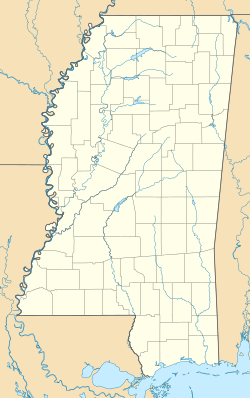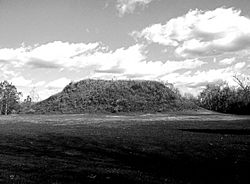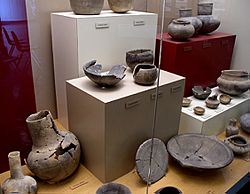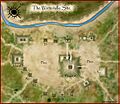Winterville Site facts for kids
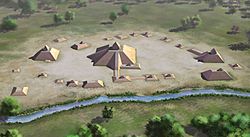
Artist's conception of the Winterville Site
|
|
| Location | Washington County, Mississippi, |
|---|---|
| Region | Washington County, Mississippi |
| Coordinates | 33°29′9″N 91°3′40″W / 33.48583°N 91.06111°W |
| History | |
| Abandoned | 1450 |
| Periods | Winterville Phase |
| Cultures | Plaquemine Mississippian culture |
| Site notes | |
| Excavation dates | 1967 |
| Archaeologists | Jeffrey P. Brain |
| Architecture | |
| Architectural styles | platform mounds, plazas |
| Architectural details | Number of mounds: 23 |
|
Winterville Site
|
|
| NRHP reference No. | 73001031 |
| Significant dates | |
| Added to NRHP | August 17, 1973 |
| Designated NHL | September 14, 1993 |
| Responsible body: State | |
The Winterville Site is a very old archaeological site in Washington County, Mississippi. It is located north of Greenville, near the river. This site has many large earth mounds and open spaces called plazas.
It is a key location for understanding the Winterville Phase (from 1200 to 1400 CE). This period belongs to the Plaquemine Mississippian culture, an ancient Native American group. Today, the Winterville Site is a state park and a National Historic Landmark.
In 2015, the state approved $300,000 to fix up the mounds. They wanted to make them look like they did long ago. New walking trails were also added to the park. The site also has a museum you can visit.
Contents
Exploring the Winterville Mounds
The Winterville Mounds are named after the nearby town of Winterville, Mississippi. This place was once a special center for ceremonies. It was built by Native American people of the Plaquemine culture. This culture was part of the larger Mississippian culture. These groups lived in the area from about 1000 to 1450 CE.
The earth mounds were very important to the Winterville people. They showed their religious and political beliefs. Sacred buildings and ceremonies took place on these mounds. Most of the mounds were built between 1200 and 1250 CE.
Who Lived at Winterville?
Archaeological studies show that most Winterville people lived on family farms. These farms were spread out across the Yazoo-Mississippi River Delta. Only a few important leaders lived at the mound center. This means the site was mainly for special events, not a big city.
The Winterville ceremonial center once had at least twenty-three platform mounds. These mounds were built around several large, flat plazas. Some mounds outside the park were destroyed by farming or road building. This happened before the site became a protected state park.
Protecting the Ancient Mounds
Today, twelve of the largest mounds are being preserved. This includes the 55-foot (17 m) tall Temple Mound. The Mississippi Department of Archives and History is working on a plan to protect them. The University of Mississippi's Center for Archaeological Research is also helping.
In 2015, money was set aside to restore the mounds. Trees and bushes that had grown on them were removed. This helps the mounds look more like they did long ago. Two walking trails were also added for visitors.
What Happened to the Winterville Site?
Archaeologists have found links between the Winterville people and the later Natchez Indians. French explorers met the Natchez in the early 1700s. The Natchez society had different social levels, passed down through the mother's family. Chiefs and leaders inherited their roles.
This strong leadership helped organize the building of the mounds. Many people worked together to create these huge earthworks. However, there is not much evidence of many people living at the site. This suggests it was mostly used for ceremonies.
A big fire happened in the late 1300s. It burned the main building on the Temple Mound. We don't know why the fire started. People still used the site after the fire. But they stopped building or taking care of the mounds.
The number of people living at Winterville slowly went down. More people moved to settlements about 50 miles south. By 1450 CE, the Winterville Mound site was completely empty. The time when the site was most active (1200 to 1400 CE) is called the Winterville Phase.
Studying the Past: Archaeology
The first modern digs at Winterville happened in the 1940s. The National Park Service and Harvard University helped with these studies. Jeffrey P. Brain led more excavations in 1967. His report, Winterville: Late Prehistoric Culture Contact in the Lower Mississippi Valley, was published in 1989.
Archaeologists found burials and old building remains. They also found items like pottery and stone tools. You can see some of these artifacts at the Winterville Museum in the park.
Winterville Mounds became a Mississippi state park in March 1969. It was named a National Historic Landmark in 1993.
Pottery from Winterville
The people of Winterville made pottery by hand. They built up clay in strips, then smoothed it out. This was common in Eastern America, where potters' wheels were not used. They mixed crushed mussel shells, grit, or bits of old pottery into the clay. This made the pottery stronger.
The pottery surfaces were sometimes polished. Some were rough, while others were very smooth. They made many shapes, from shallow bowls to tall jars. Some pieces even had animal shapes as handles. Decorations included plain surfaces or carved designs. These designs often related to the Southeastern Ceremonial Complex, a shared art style.
Most pottery found at Winterville is called Addis Plain. This includes different types like Addis, Greenville, and Holly Bluff. Some pottery found here was brought from other Mississippian groups. These might have come from places like Cahokia. Examples include pottery from the Nodena and Walls cultures. These pieces have special red and white colors. They also have thinner walls and smoother finishes. People likely valued them because they were unique and well-made.
Images for kids


